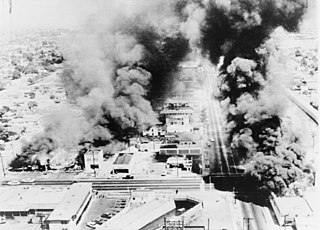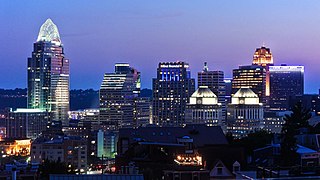In the broader context of racism in the United States, mass racial violence in the United States consists of ethnic conflicts and race riots, along with such events as:

The 1967 Detroit riot, also known as the 12th Street Riot, was the bloodiest of the urban riots in the United States during the "Long, hot summer of 1967". Composed mainly of confrontations between black residents and the Detroit Police Department, it began in the early morning hours of Sunday July 23, 1967, in Detroit, Michigan.

The Watts riots, sometimes referred to as the Watts Rebellion or Watts Uprising, took place in the Watts neighborhood and its surrounding areas of Los Angeles from August 11 to 16, 1965.
The 2001 Cincinnati riots were a series of civil disorders which took place in and around the Over-the-Rhine neighborhood of downtown Cincinnati, Ohio from April 9 to 13, 2001. They began with a peaceful protest in the heart of the city on Fountain Square over the inadequate police response to the police shooting of unarmed African American 19-year-old Timothy Thomas. The peaceful protest soon turned into a march that went in the direction of the victim's home neighborhood of Over-the-Rhine.
Dwight Tillery is an American politician and social justice activist with more than 50 years of service working towards equity for African Americans and other minorities in politics, business and public health. His leadership transformed the lives of Black residents in the city of Cincinnati in the areas of racial justice, education, civics, community health and politics. Tillery was the first popularly elected Black Mayor in Cincinnati, Ohio, serving from 1991-1993, and he served on the Cincinnati City Council for 8 years. Tillery co-founded the United Black Students Association at the University of Cincinnati, was the Founder, President and CEO of The Center for Closing the Health Gap, and co-founded The Black Agenda of Cincinnati. Tillery also served as an Adjunct Professor at the University of Cincinnati and at Miami University.

Evanston is one of the 52 neighborhoods of Cincinnati, Ohio. A mostly African-American neighborhood since the 1960s, it is known as "the educating community," and is bordered by the neighborhoods of East Walnut Hills, Hyde Park, North Avondale, and Walnut Hills, as well as the City of Norwood. The population was 8,838 at the 2020 census.

The Hough riots were riots in the predominantly African-American community of Hough in Cleveland, Ohio, United States which took place from July 18 to 23, 1966. During the riots, four African Americans were killed and 50 people were injured. There were 275 arrests and numerous incidents of arson and firebombings. City officials at first blamed black nationalist and communist organizations for the riots, but historians generally dismiss these claims today, arguing that the cause of the Hough Riots were primarily poverty and racism. The riots caused rapid population loss and economic decline in the area, which lasted at least five decades after the riots.
William McMillan was a lawyer, Judge, County Commissioner, and Delegate to the 6th United States Congress from the Northwest Territory. He was among the first settlers of what would become Cincinnati, Ohio.
Walton H. Bachrach was a businessman, lawyer, and Republican politician who served as the mayor of Cincinnati from 1961 to 1967 and on the City Council from 1953 to 1967.

The Cincinnati Strangler was the name given to an American serial killer responsible for the murder of seven women in Cincinnati, Ohio, between December 1965 and December 9, 1966. During the investigation, a local resident, Posteal Laskey Jr., was declared the main suspect in the killings and was arrested on December 9, 1966, for one of the murders for which he was subsequently convicted. Although he was never charged with the other murders, the media and police blamed him for the other deaths since according to the official version of the investigators, the murders ceased after his arrest.

Cincinnati is a city in and the county seat of Hamilton County, Ohio, United States. Settled in 1788, the city is located at the northern side of the confluence of the Licking and Ohio rivers, the latter of which marks the state line with Kentucky. The city is the economic and cultural hub of the Cincinnati metropolitan area and has an estimated population of 2,265,051. The city is Ohio's largest metropolitan area and the nation's 30th-largest city. The population of Cincinnati is 309,317 which makes the city the third-most populous city in Ohio after Columbus and Cleveland, and 65th in the United States.

Corryville is one of the 52 neighborhoods of Cincinnati, Ohio. It is located immediately east of the University of Cincinnati, southeast of Clifton, south and west of Avondale, northwest of Walnut Hills, and north of Mount Auburn. The population was 4,373 at the 2020 census.

Sedamsville is one of the 52 neighborhoods of Cincinnati, Ohio. Established in 1795 and annexed in 1870, the neighborhood lies along the Ohio River in the western part of the city. The population was 1,256 at the 2020 census.

The long, hot summer of 1967 refers to the more than 150 race riots that erupted across the United States in the summer of 1967. In June there were riots in Atlanta, Boston, Cincinnati, Buffalo, and Tampa. In July there were riots in Birmingham, Chicago, Detroit, Minneapolis, Milwaukee, Newark, New Britain, New York City, Plainfield, Rochester, and Toledo.
The Cincinnati race riots of 1829 were triggered by competition for jobs between Irish immigrants and native blacks and former slaves, in Cincinnati, Ohio, United States but also were related to white fears given the rapid increases of free and fugitive blacks in the city during this decade, particularly in the preceding three years. Merchants complained about the poor neighborhoods along the river as having ill effects on their waterfront shops and trade with southern planters. Artisans excluded blacks from apprenticeships and jobs in the skilled trades. In June 1829 overseers of the poor announced that blacks would be required to post surety bonds of $500 within 30 days or face expulsion from the city and state. This was in accord with a 1807 Black Law passed by the Ohio legislature intended to discourage black settlement in the state.
The history of Over-the-Rhine is almost as deep as the history of Cincinnati. Over-the-Rhine's built environment has undergone many cultural and demographic changes. The toponym "Over-the-Rhine" is a reference to the Miami and Erie Canal as the Rhine of Ohio. An early reference to the canal as "the Rhine" appears in the 1853 book White, Red, Black, in which traveler Ferenc Pulszky wrote, "The Germans live all together across the Miami Canal, which is, therefore, here jocosely called the 'Rhine'." In 1875 writer Daniel J. Kenny referred to the area exclusively as "Over the Rhine". He noted, "Germans and Americans alike love to call the district 'Over the Rhine'."
Pill Hill is an informal name for a neighborhood in uptown Cincinnati, Ohio. It is one of the city's major employment centers, with a large concentration of hospitals and other medical facilities.













